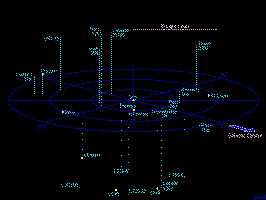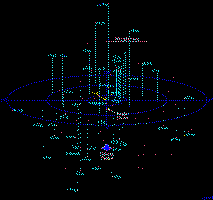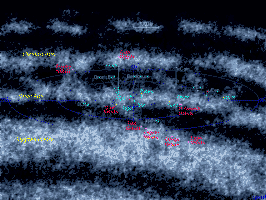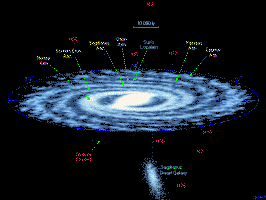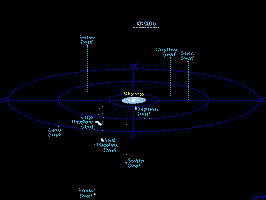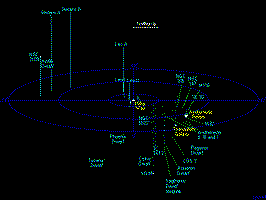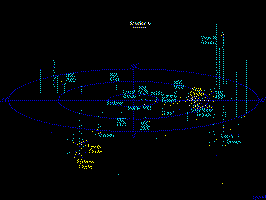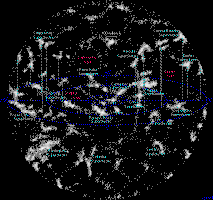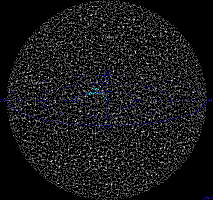|
The Verdants
An earnest,
well-regarded journalist who speaks with no outward sign of
dishonesty, Krapf suggests that he may have been selected for the
encounter because he’s a reputable professional who had previously
been skeptical about aliens and UFO’s. Krapf won a Pulitzer Prize as
editor of what was then one of the best newspapers in the country.
He did fact checking and was responsible for steering reporters and
removing inaccuracies in their stories. Given his conservative,
mainstream stature, he may be the most well-regarded witness of his
sort, to date.
The first was Alec Newald’s book, Coevolution, about a ten-day journey to the planet of a competing alien group called the Elders.
* There have been other books about interactions that some readers might consider diplomatic, yet they were neither as prolonged and explicit, nor as recent as Krapf’s and Newald’s books, in which aliens appear to have gone out of their way to accommodate the writers by providing psychotronically effected, near-total recall. Apparently, this was done in order to facilitate publication of both stories.
Given the
frequency of recent contacts and sightings, paralleled by a cryptic
dribble of human official disclosures, these three books stand out
in a fast-developing, new context. Krapf writes that he was taken
for a second visit with the Verdants three years later in 2000.
Each of the additional 17,000 planets is reportedly inhabited by a different alien species. Given that a large galaxy like our own contains roughly 150 billion stars, there should be many habitable planets in a typical galaxy. So, we shouldn’t conclude that Verdant numbers mean that they control a number of other large galaxies.
A single large spiral galaxy could contain
most of the Verdant alignment.
Verdant incursions here, some of which reportedly involve gray alien abductions of humans, may have accelerated our awareness of off-world dynamics. Krapf writes that in a series of meetings on a 1 ½ mile diameter, disk-shaped Verdant ship with many windows and entry ports, Verdants admitted that they have orchestrated years of human abductions for scientific and breeding purposes prior to attempting a diplomatic opening to humankind.
Electrogravity was apparently used to slow
certain brain processes and render abductees semi-conscious so that
they wouldn’t remember such events.
Krapf later spoke with the man, who
fearfully admitted involvement. Krapf saw a list plus photos of
hundreds of other human contacts for the Verdant diplomatic
initiative. For yet-unspecified reasons, the projected Verdant
opening was delayed several years past its planned date. Krapf says
the Verdants he met seemed reticent yet certain that Verdants would
succeed in setting the agenda here, which seems ironic because Verdants proposed that they be allotted 600 square miles of empty
land in the US Southwest to build a center for interaction with
humans.
So, in a sense, if Krapf’s story is correct, the delay in an opening by the Verdants isn’t simply a delay. Instead, it may be due to the fact that the Verdants have little chance here, yet due to wishful thinking within their bureaucracy, plus the extent of their abduction and breeding infiltration of certain human sectors, they must go through the motions of an opening (if not some bitter, last-minute attempts at manipulating humans toward such ends).
Apparently, further delays diminish the Verdants’ chances here
because humans become more technologically capable and informed with
time.
Instead, it refers
to individuals who, unknown to other humans, work directly for the Verdant IFSP to bend human events in favor of IFSP (Intergalactic Federation of
Sovereign Planets) control here.
Such humans may have genetic and other IFSP contributions that go
unnoticed. The source for this report and his colleagues have
provided breakthrough information at various junctures. Leery of
damages done by IFSP manipulators, they seem to want to help humans.
Based upon simple negative energy aspects of remote sensing, this method can be practiced by most humans. First, you must practice remote sensing, which uses the human nerve structure to “feel” around those sites or events that involve IFSP aliens and look for their signature kind of electrogravity streaming.
Such electrogravity streams stand out starkly, compared to the ambient background, and usually trace back to an IFSP technology site instantaneously. What makes this easy is that fact the different kinds of electrogravity used by different populations have different energy signatures (especially the psychotronic component).
Given that such electrogravity streams are full of detailed information content, sorting them out is fairly easy, once a person has learned to:
Although a less common option, the latter
method is quite effective. Advanced remote sensing can even detect
past IFSP interactions with the “direct operative” in question. This
is possible because electrogravity (and negative energy) span and
connect outwardly (and inwardly) more extensively than is often
immediately apparent.
Author’s note: no direct harm is intended to any individual, and readers should know that those who simply sympathize with, or are more generally entranced by new alien encounters are not considered “direct operatives.” Direct operatives would have no compunction about doing harm to both this planet and its inhabitants in order to serve the IFSP agenda, while a mere aficionado would recoil at the thought. (Krapf isn’t a direct operative.)
The
situation is quite serious because Verdant resources would have
allowed them to give material and other advantages to their direct
operatives over many years’ time. Given the Verdant record
elsewhere, Verdant designs on the resources and energy environment
here could be cause for concern.
Phillip Krapf reports that on his first three-day visit to the Verdants’ disk-shaped cruiser he was,
Ambassadors are humans
reportedly taken to the Verdant ship to be indoctrinated, then used
in a Verdant plan to absorb planet Earth within the IFSP. (The
Challenge of Contact, p. 13)
Senator John Stennis wrote a glowingly favorable preface for the book, but then tried to retract it later.
Writing with co-author
and UFO magazine publisher William Birnes, PhD, Corso suggested
that, beginning with Harry Truman and climaxing with
the Eisenhower
administration, US defense and intelligence officials privy to an
alien crash at Roswell began to fear that grays and affiliated
aliens posed a threat. Part of the fear is attributed to frustration
within the military, the inability to either explain or compete with
such aliens; part of it may have been a kind of spin that was put on
the subject during the editing process.
The Virgo supercluster contains some 2000 galaxies.
In short, Verdants would represent but one galaxy out
of a vastly larger 50 billion to 100 billion galaxies within the
larger, visible universe. Alien competitors of the Verdants go out
of their way to emphasize this fact with specific reference to the
Verdants, by the way. Further reports have partly corroborated
Krapf’s story about the Verdants. For example, hundreds, if not
thousands of witnesses say they have encountered gray aliens working
on a breeding program, which is further evidence of the current
Verdant-IFSP presence in our system. Because abducteé and
experiencer reports from all over the globe often mesh consistently,
we should give Krapf’s reports their due consideration.
Disputes arise because, like many humans, I’m actively
critical of Verdant-gray intentions. Prior to reading Krapf’s book I
had no clearly defined context in which to identify Verdants (who
were extant at the time) because Verdants normally try to obscure
themselves behind lesser, dependent aliens of their group, i.e. the
grays and human-gray hybrids. It’s both a matter of pride and
official priority that they do so.
* Caution is advised, however.
In a
larger context, there are much greater considerations.
* In a larger sense, one can imagine an alien sitting in a neighboring galaxy supercluster and reading about the situation here, then wincing because it reminds him/her of a similar situation there.
Incidentally, the galaxy M-83 matches both the size, and the location that Phillip Krapf describes as being home to the Verdants.
M-83 is a spiral galaxy located in the Centaurus A galaxy group. A few alien sources have suggested that M-83 is, in fact, the Verdant home.
In addition, one highly detailed map was communicated to indicate Verdant outposts in other galaxies. In the map, communicated by an alien significantly more evolved than the Verdants who monitors the situation here closely, Verdant IFSP outposts are concentrated in the Centaurus A galaxy group, primarily centering on the galaxy M-83, but fingering into other galaxies of Centaurus A.
If I’m not mistaken, the Verdants aren’t the most numerous population in the other two large spirals of their home galaxy group. Instead, other native populations are more numerous.
Verdant outposts also finger lightly into galaxies of the five galaxy groups nearest Centaurus A:
...which broadens out into the Virgo supercluster of galaxies.
Apparently, as is noted later in
this book, the native populations of those five galaxy groups are
dominant there, not the Verdants. All five galaxy groups are small
groups containing but 3-7 large galaxies and a few dozen smaller
irregular or elliptical galaxies.
Why the ecology? Because there are no unlimited quantities in the known universe. }
Rather than assume that unoccupied territory is simply open for the
taking, humans have been advised to remember that all large galaxies
are already inhabited by advanced civilizations. In other words, the
most important task for humans, now, is to be self-sufficient and
learn about more responsible alien populations, rather than stumble
out in pig-headed search of real estate.
Should
we continue down our present, one-way street toward global
ecological breakdown, we can expect the larger off-world community
to either distance itself from the regimes here or try to convince
humans to compel a change before we become a threat to our
neighbors. People who interact with aliens say that advisories of
the sort are an everyday occurrence.
Maybe we can learn how to avoid global failure by studying alien social dynamics more rigorously.
Aliens touch upon such
themes during interactions with a growing number of humans. Aliens
further suggest that such considerations are now so obvious as to be
mathematically explicit.
|
||||||||||||
